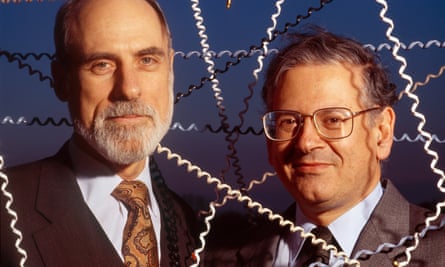the world wide web (and more)
So if you're reading this, you've probably heard about the World Wide Web, (duh, or you wouldn't be reading this right now) and as some people refer to it, the internet. These are actually two different things, but they get thrown around in unison a lot. But have you ever taken a second to think about who the lunatic that thought to create the internet (and paved the way for the creation of the World Wide Web) was a good idea was? In this blog post I'll be going over information about the World Wide Web, the Internet, and some other cool information. What's the other information you ask? Read until the end to find out!
The World Wide Web

Photo: CERN Website
The year is 1989, and Sir Tim Berners-Lee is working diligently as a software engineer at CERN, a particle physics lab near Geneva, Switzerland. It was a normal day for Tim, and that was until he realized, scientists from all over the world come and do experiments with the particle accelerator at CERN, but they always had an issue with sharing data. This is when Tim decided it was time for a piece of software that could help send data across the world in seconds. The internet had already been created, but by exploiting a new technology called hypertext, Tim saw that he could create exactly what he wanted.
In March of 1989, Tim created a proposal laying out the blueprints for what would be come the web in a document called "Information Management: A Proposal." When first presented to Tim's boss at the time, Mike Sendall, it was not accepted. I think a main reason why it wasn't was because the document reads "Vague but exciting," and Tim's boss wasn't too sure if it would work. But, as the web was never an official CERN project, Mike gave Tim time to work on it in September of 1990 on a NeXT computer.
In October of 1990, Sir Tim Berners-Lee had finally finished the three main protocols that would run the World Wide Web; HTML (HyperText Markup Language), URI (Uniform Resource Identifier) and HTTP (Hypertext Transfer Protocol). These three protocols were and still are the building blocks to what we know as the World Wide Web today. Tim also created the world's first web editor and browser, WorldWideWeb.app, and the first web server, "httpd." The World Wide Web was an invite only service during it's release in 1991, until Tim realized the only way for it to truly flourish, was by making it free and accessible to anyone without asking for permission.
The Internet

Photo: Louie Psihoyos/Corbis
The creation of the Internet is a fascinating one, as the Internet wasn't created by solely one person, but rather multiple individuals and teams over the span of around 40 years. For this blog, I'll only be focusing on Bob Khan and Vint Cerf, as they created the main protocols that govern how data is moved over a network. I would love to explore more about the internet, but then this blog would be like 40 pages long, and I'll save you guys the reading.
In 1974, Khan and Cerf proposed a new and more efficient method of sending data, which involves sending data through digital 'packets' called a 'datagram.' These datagrams were encrypted, and while they could be read by any computer, only the final host machine can turn the packet into the data being sent. Khan and Cerf called this method TCP, and allowed computers to speak the same language. TCP combined with an IP (Internet Protocol) helps direct internet traffic. IPs can be read by any computer in the world, and can help locate where data came from, which is why it is always important to use a VPN when exploring the web. You don't need a crazy expensive VPN either, a good free service like Proton VPN works fine.
Wi-Fi, Bluetooth, and Hedy Lamarr

Photo: Alfred Eisenstaedt/The LIFE Picture Collection/Getty Images
So you're probably wondering, "Who the heck is Hedy Lamarr?" Hedy Lamarr was an Austrian-American actress, who wasn't only beautiful, but was also a very smart inventor. Hedy was born on November 9th, 1914, and was an only child. This meant she spent a ton of time with her father, and when they would take walks, he would discuss how machines worked at the time with her, such as cars and manufacturing machines. This left a big impacts on Hedy, and by 5 years old she was taking apart her music boxes and putting them back together to see how the inner working mechanisms worked.
But, even though Hedy showed great interest and promise in engineering, her mother put her in ballet and piano lessons. When she was discovered by director Max Reinhardt at age 16 is when she was thrown into the world of acting. It wasn't until Hedy met Howard Hughes that her innovative mind flourished. Hedy and Howard dated, and he gave her a small set of equipment so that she could work on her inventions on set between takes. This made it easier for Hedy to work on her inventions, because while she already had an inventing table in her house, it wasn't viable to go all the way there every time she had an idea. After Howard gave her access to the scientists at all of the companies he owned, Hedy went on to create an improved stoplight and a tablet that dissolved in water to make a soda.
Alright so, what's the connection between Hedy Lamarr and Wifi and Bluetooth? Well, in 1940, Hedy met George Antheil at a dinner party and spoke about not feeling comfortable sitting in Hollywood and making tons of money while there was a war going on. Hedy had gained knowledge on munitions and various weapons from a prior marriage, so Hedy and George began to brainstorm ideas to help defeat the axis powers.
Together, they created a new communication system, created for guiding torpedos to their target during the war. They used a technique called frequency hopping on radio wave, which is where both the transmitter and receiver hop to new frequencies together. This prevented the radio waves from being intercepted, which in turn led the torpedo to its target. After Hedy and George created this, they went and patented it and looked for military support for the invention. They received their patent (U.S. Patent No. 2,292,387) in August, 1942, but the Navy wasn't on board with the idea and decided not to implement it.
The patent expired before she could profit from it, but she was inducted into the National Inventors Hall of Fame in 2014, 14 years after she had passed. The technology Hedy and George created paved the way for things we take for granted everyday, such as Wifi and Bluetooth, two process that rely on frequency hopping technology.
Sources:


Comments
Post a Comment